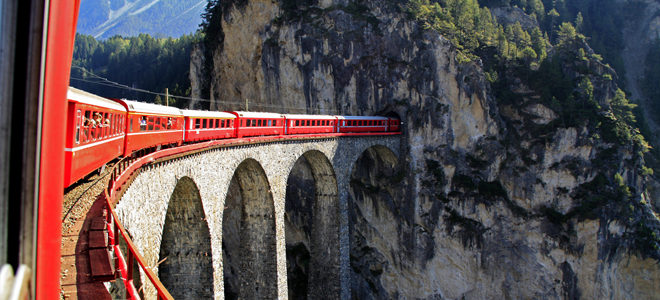The Glacier Express
The Glacier Express & Bernina Express
The Glacier Express is one of the most famous railway journeys in the world passing through running through 91 tunnels and across 291 bridges and reaching an altitude of 2,033m above sea level as it winds its way for 180 miles between Zermatt and St. Moritz.
Rhaetian Railways
It’s a touch ironic that the audacious idea of building a mountain railway in Graubuenden came from a Dutchman named Willem-Jan Holsboer. Ground was broken in 1888 and, for the next 20 years or so, through engineering ingenuity and punishingly hard work the routes known as the ‘Glacier Express’ and ‘Bernina Express’ were given to the world. Today they are run by the ‘Rhaetian Railway’ train company. The exceptional nature of the Rhaetian Railways was recognised in 2008 when much of the network was incorporated into the UNESCO list of world heritage sites.
The Glacier Express
The longer of the two journeys is the Glacier Express which eases out of Zermatt station and arrives in St Moritz seven and a half hours later. Incidentally, ‘express’ in the sense of a high speed journey is a misnomer as the average speed is a serene 22 mph; but the last thought on anyone’s mind is will the train to go faster. From Zermatt at 1,800 m the train meanders its way down the valley to Visp and Brig where it begins to climb encountering the first spiral tunnel as the train enters the Goms Valley.
From here its uphill all the way to the Oberalp Pass at 2,033 m, firstly through the 15km long Furka Base Tunnel, opened in 1982, and then by way of the ski resort of Andermatt where the track rises steeply through a series of horseshoe shaped bends. All the while one never loses sight of the panoramic views that slide by – jagged mountains, unspoilt forests, peaceful meadows and valleys and glimpses of a Switzerland far removed from cosmopolitan holiday resorts. So you don’t miss a thing, a commentary is provided through headphones with a choice of languages.
From Oberalp, the descent begins towards Chur, the capital of Graubuenden, before beginning to climb again following the course of the Rhine towards the truly remarkable Albula line. Between Bergun (1,373 m) and Preda (1,789m), a distance of 5km as the crow flies, a distance covered by 13 km of track, the train has to rise 400m achieved by three spirals and three horseshoe loops, some of which are in tunnels, plus nine viaducts and two cuttings. This singularly incredible feat of engineering was achieved by the toil and sweat of 5,000 workers between 1898 and 1903.
Finally, the train arrives in St Moritz, having completed its journey from Zermatt and the Matterhorn to Piz Bernina, to rendezvous with Bernina Express bound for the Bernina Pass and onwards into Tirano, Italy.
For more information go to www.rhb.ch/Glacier-Express
The Bernina Express

The Bernina Express route is a much shorter journey than the Glacier Express but is every bit as dramatic. As the ‘little red train’ moves away from Pontresina near St Moritz, the massif of the Bernina group comes into view and the train begins its climb on the journey south to Italy. One of the more dramatic sights in Graubuenden is the Morteratsch Glacier and in 1908 a train station was built at the foot of the glacier. Regrettably, in 2009, as a result of global warming, the railway station is now a good, but worthwhile, 30 minutes walk from the glacier edge.
From here the line climbs steeply utilising the almost trademark spiral turns to the high point of the journey at Ospizio Bernina (Bernina Pass) at 2,253m. En route, the train winds its way past the translucent green water of Lago Bianco and the cable car stop at Diavolezza. The Bernina line is characterized by a number of stops where you can get off the train, enjoy a walk, and rejoin the train either at the same stop or a bit further up or down the line. For example, the walk from Ospizio Bernina via Lago Bianco and its neighbour Laj Nair (Black Lake) to Alp Grum will take about two hours.
From the high point, the Romansch speaking part of Graubuenden is left behind as the train begins its steep descent towards the Italian speaking enclave of Val Poschiavo; but if time permits, get off at Alp Grüm, and enjoy a drink or a meal on the station restaurant terrace which overlooks the inspiring sight of the Palu Glacier. After Alp Grüm the train drops through tight bends and tunnels, through a changing environment of sparse trees to a greener and more colourful world before arrival at the small town of Poschiavo, sitting just north of Lake Poschiavo. Not many people know that well-heeled Brits came here a century ago to indulge in the rich man’s pastime of skiing. Not that there were any lifts – they would hike up the mountains overlooking the lake and ski down. Poschiavo has a delightful little square with cafes and shops, and the church by the square has a slightly macabre ossuary.
From Poschiavo, the jewel in the crown on the Bernina line is found at Brusio where the engineers found a unique way of dealing with the gradient – a nine arched spiral viaduct, where the line passes under itself before heading on down the valley and to Tirano. It’s 38.4 km from the Bernina Pass to Tirano, and over that short distance, the drop in altitude is more than 1,800m!
While both lines are now popular year-round tourist attractions, when they were conceived and built it was the fruit of a vision to bring communication and economic development to remote communities living very hard lives, and for that we have to thank a Dutchman.
For more information go to www.rhb.ch/Bernina-Express
Sponsor: Rhaetian Railways
Rhaetian Railways, Tel: +41 (0) 81 288 65 65, Web: www.rhb.ch












